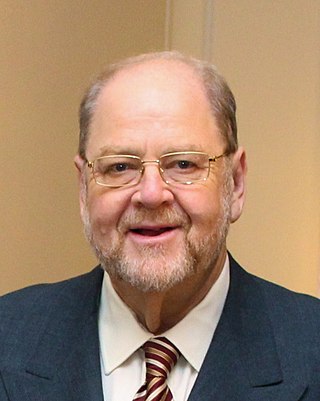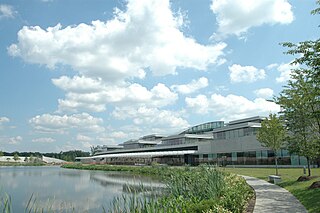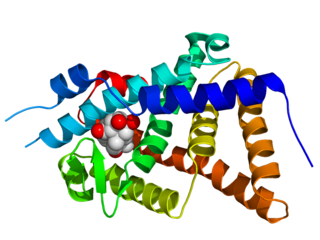Juvenile hormones (JHs) are a group of acyclic sesquiterpenoids that regulate many aspects of insect physiology. The first discovery of a JH was by Vincent Wigglesworth. JHs regulate development, reproduction, diapause, and polyphenisms. The chemical formula for juvenile hormone is .

Earl Wilbur Sutherland Jr. was an American pharmacologist and biochemist born in Burlingame, Kansas. Sutherland won a Nobel Prize in Physiology or Medicine in 1971 "for his discoveries concerning the mechanisms of the action of hormones", especially epinephrine, via second messengers, namely cyclic adenosine monophosphate, or cyclic AMP.

James Edward Rothman is an American biochemist. He is the Fergus F. Wallace Professor of Biomedical Sciences at Yale University, the Chairman of the Department of Cell Biology at Yale School of Medicine, and the Director of the Nanobiology Institute at the Yale West Campus. Rothman also concurrently serves as adjunct professor of physiology and cellular biophysics at Columbia University and a research professor at the UCL Queen Square Institute of Neurology, University College London.
Holometabolism, also called complete metamorphosis, is a form of insect development which includes four life stages: egg, larva, pupa, and imago. Holometabolism is a synapomorphic trait of all insects in the superorder Endopterygota. Immature stages of holometabolous insects are very different from the mature stage. In some species the holometabolous life cycle prevents larvae from competing with adults because they inhabit different ecological niches. The morphology and behavior of each stage are adapted for different activities. For example, larval traits maximize feeding, growth, and development, while adult traits enable dispersal, mating, and egg laying. Some species of holometabolous insects protect and feed their offspring. Other insect developmental strategies include ametabolism and hemimetabolism.

Janelia Research Campus is a scientific research campus of the Howard Hughes Medical Institute that opened in October 2006. The campus is located in Loudoun County, Virginia, near the town of Ashburn. It is known for its scientific research and modern architecture. The current Executive Director of the laboratory is Ronald Vale, who is also a vice-president of HHMI. He succeeded Gerald M. Rubin in 2020. The campus was known as "Janelia Farm Research Campus" until 2014.
In evolutionary psychology, people often speak of the four Fs which are said to be the four basic and most primal drives that animals are evolutionarily adapted to have, follow, and achieve: fighting, fleeing, feeding and mating.

Otto Knut Olof Folin was a Swedish-born American chemist who is best known for his groundbreaking work at Harvard University on practical micromethods for the determination of the constituents of protein-free blood filtrates and the discovery of creatine phosphate in muscles.

Cotesia congregata is a parasitoid wasp of the genus Cotesia. The genus is particularly noted for its use of polydnaviruses. Parasitoids are distinct from true parasites in that a parasitoid will ultimately kill its host or otherwise sterilize it.

The enzyme juvenile hormone esterase (EC 3.1.1.59, systematic name methyl-(2E,6E,10R)-10,11-epoxy-3,7,11-trimethyltrideca-2,6-dienoate acylhydrolase, JH esterase) catalyzes the hydrolysis of juvenile hormone:

The ecdysone receptor is a nuclear receptor found in arthropods, where it controls development and contributes to other processes such as reproduction. The receptor is a non-covalent heterodimer of two proteins, the EcR protein and ultraspiracle protein (USP). It binds to and is activated by ecdysteroids. Insect ecdysone receptors are currently better characterized than those from other arthropods, and mimics of ecdysteroids are used commercially as caterpillar-selective insecticides.
The Howard Vollum Award for Distinguished Accomplishment in Science and Technology is an annual award that was created by Reed College and endowed in 1975 by a grant from the Millicent Foundation, now a part of the M.J. Murdock Charitable Trust.
Harold Abraham Scheraga was an American biophysicist and the George W. and Grace L. Todd Professor Emeritus in the chemistry department at Cornell University. Scheraga is regarded as a pioneer in protein biophysics and has been especially influential in the study of protein solvation and the hydrophobic effect as it relates to protein folding.
Nuggehalli Raghuveer Moudgal was an Indian reproductive biologist, endocrinologist and the chairman of the Department of Biochemistry and dean of Faculty of Science at the Indian Institute of Science. He was known for his pioneering researches on gonadotropin and was an elected fellow of the Indian Academy of Sciences and the Indian National Science Academy. He was an associate of noted scientists, Choh Hao Li and Rodney Robert Porter and discovered the role of hormones in generating immune response in living beings, during his association with the former. The Council of Scientific and Industrial Research, the apex agency of the Government of India for scientific research, awarded him the Shanti Swarup Bhatnagar Prize for Science and Technology, one of the highest Indian science awards for his contributions to Medical Sciences in 1976.
Eric Gouaux is an American biochemist and biophysicist who holds the Jennifer and Bernard Lacroute Term Chair at the Vollum Institute at the Oregon Health & Science University.
James "Jim" William Truman is an American chronobiologist known for his seminal research on circadian rhythms in silkmoth (Saturniidae) eclosion, particularly the restoration of rhythm and phase following brain transplantation. He is a professor emeritus at the University of Washington and a former senior fellow at Howard Hughes Medical Institution Janelia Research Campus.

Nancy Elizabeth Beckage was an American entomologist known for her work on host–parasitoid interactions. She held professorships in entomology and in cell biology and neuroscience at the University of California, Riverside.
Michael R. Kanost is a University Distinguished Professor in the Department of Biochemistry and Molecular Biophysics at Kansas State University.
Marta Zlatic is a Croatian neuroscientist who is group leader at the MRC Laboratory of Molecular Biology in Cambridge, UK. Her research investigates how neural circuits generate behaviour.
Juvenile hormone acid O-methyltransferase (JHAMT) is a ~33 kDa enzyme that catalyzes the conversion of inactive precursors of Juvenile hormones (JHs) to active JHs in the final stages of JH biosynthesis in the corpora allata of insects. More specifically, the enzyme catalyzes the transfer of a methyl group from S-adenosyl-L-methionine (SAM) to the carboxylate group of JH precursors.

Condylognatha or Panhemiptera is a monophyletic grouping (superorder) that contains Hemiptera and Thysanoptera (thrips). Condylognatha belongs to Paraneoptera, which include its sister group, lice (Psocodea).









